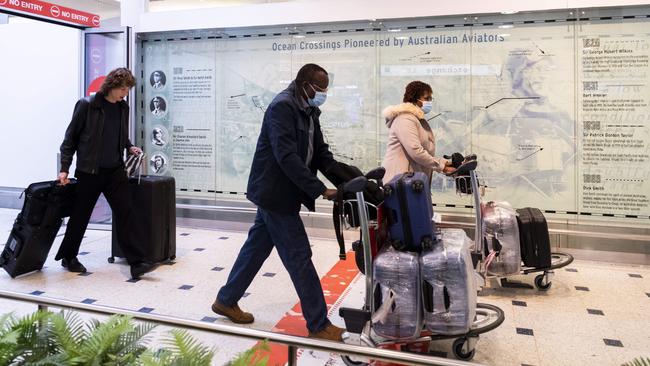
Immigration has been in the news lately as various submissions are released to the government-commissioned review, A Migration System for Australia’s Future. Unsurprisingly, most of them simply talk the book of the sponsoring body.
The submission of the Business Council of Australia, for example, calls for an even higher migrant intake (from 195,000 to 220,000) with future intakes set as a percentage of the population.
The Australian Chamber of Commerce and Industry wants streamlined pathways for temporary migrants to secure permanent residency.
The most depressing aspect of the submissions is the narrow perspective they take. In particular, there is a glaring failure to acknowledge that there are both costs and benefits associated with immigration and that not all the costs and benefits are economic or calculable.
It’s worth returning to first principles when thinking about an optimal immigration policy. The first is to recognise that a higher migrant intake will make the economy bigger but will not necessarily result in higher per capita income. In other words, being bigger is no guarantee of being wealthier. There is no convincing evidence that migration has boosted productivity.
The second important principle is that there are winners and losers when it comes to immigration. The biggest winners are the migrants themselves, a point demonstrated by the Productivity Commission. But owners of capital and workers with skills that are complementary to migrants are also beneficiaries. Workers whose skills are substitutes with migrant workers will often lose out.
Third, the supposed effect of immigration on the demographic profile of the population is very marginal, in part because migrants age themselves.
Those who advocate for higher migrant intakes because migration slows the ageing of the population also overlook the visa categories that permit the entry of older migrants such as the Parent and Investor Visa programs.
Fourth, it is only skilled migrants who generate estimated positive fiscal impacts, with family and humanitarian entrants associated with large budgetary drains. The idea that more migrants are needed so we can pay less tax is highly misleading because this depends critically on the migrants who are approved and what they do. The reality is that it is simply not possible to run a skilled migration program without a family stream; permanent migrants will always seek to be reunited with their family.
We also have to be careful about the definition of skill. Just because an applicant has a university qualification, even one obtained from an Australian institution, does not make that person skilled. Indeed, there is evidence, including from the work of demographer Bob Birrell, indicating that many independent skilled migrants do not work in skilled occupations.
Finally, many of the benefits and costs of migration are not captured by normal economic data. This is particularly the case with costs, which include congestion, crowded schools and hospitals and loss of cultural cohesion and urban amenity.
The notion that these costs can be completely offset by better infrastructure planning and implementation is naive and unrealistic. There is also the issue of the current spate of extreme cost overruns and the delayed completions of many infrastructure projects that would not have been required had the population been allowed to grow more slowly.
It’s worth outlining what has happened to immigration over the past several years. Needless to say, the pandemic significantly impacted both inflows and outflows of migrants for a period of time. Prior to that, net overseas migration (the difference between long-term inflows and outflows, both permanent and temporary) had been running at around 250,000 per year, making up some two-thirds of population growth. Most migrants headed to Melbourne, Sydney and the southeast corner of Queensland.
It is estimated that Australia’s population could be lower by close to one million because of the interruption of the pandemic. But here’s the thing: survey after survey has demonstrated that the majority of people do not support high migrant intakes and would be very happy with slower population growth. Neither the Coalition or Labor has shown any tendency to take into account public opinion on this matter.
Now the border restrictions have all been lifted, the surge in migration is gathering pace. There is a possibility that net overseas migration could reach 300,000 this year. The number of student visas being issued is at record levels, with students from India dominating the intake.
We know from research that a clear majority of students from India intend to stay in Australia. (Students from China are less likely to stay although the duration of their residence in Australia can often be close to a decade.)
In the meantime, international students form a significant part of the unskilled and semi-skilled workforce, particularly given the lifting of restrictions on their work rights. There is no doubt that the hospitality and retail sectors, in particular, welcome the return of this source of labour, easing the pressures many employers were under to lift wages.
More generally, the tight labour market, with unemployment at about 3.5 per cent, appears to support the case for a higher migrant intake, at least in the short term. Bear in mind that unemployment is a lagging indicator and it’s likely that the labour market will soften in the coming months as the impact of higher interest rates is felt. Note also the cripplingly tight rental housing market that underscores the poor timing of allowing in more migrants.
There is no doubt the current configuration of visa categories and the attached conditions is difficult to understand and carries high compliance costs, for applicants and employers. There have been unacceptable delays in the processing of visa applications, although this situation is improving.
The lists of skilled occupations that qualify should be ditched, in part because individual commissions and omissions make no sense but also because of the scope for gaming. The requirement for labour market testing – employers are required to see whether a position can be filled by a local – is also gamed. A cleaner approach is to insist on a minimum pay for temporary skilled migrants, in particular. Care needs to be taken, however, that employers don’t simply deduct inflated accommodation costs and other expenses to get around this requirement.
The bottom line is that the government should not lock in the current higher migrant intake, let alone increase it further. There is actually a strong case for returning to a lower figure – it was 160,000 under the Coalition – given the public’s preferences and the clear costs of immigration, including the current poor timing. Agreeing to the demands of employers and other beneficiaries (think universities and property developers, in particular) while ignoring the broader population who bear the external costs is not governing in the national interest.







